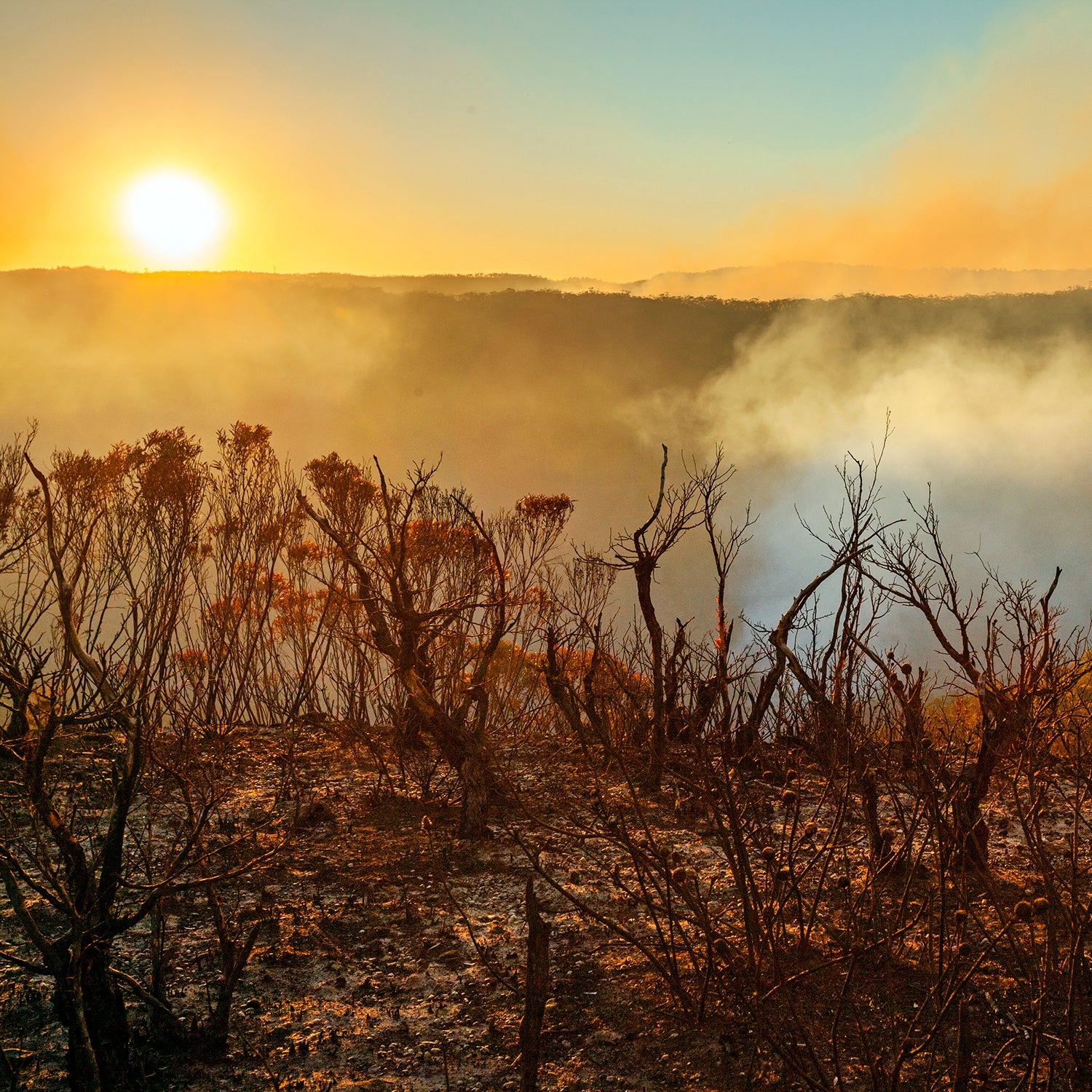Recently, a few friends and I stood around a patio for a makeshift holiday party. We were outside and socially distancing again, and one friend had their new baby with them. Perhaps because there was a tiny human present, with her whole life in front of her, we got to talking about the future and how so many of the scary things we imagined about what climate change would look like became reality in 2021.
From last January’s crippling freezes in Texas to last week’s , it feels like we’ve been hit with one disaster after another. And the systems that need to change to ensure our future viability have been too slow to respond. But as the new year commences, there are some opportunities to make real progress. Here’s where the climate and environment stand now, including the problems we most urgently need to address and the things already moving in the right direction.
The Bad:
Species Are in Decline
In September, the U.S. Fish and Wildlife Service removed 23 species from the endangered-species list and declared them . That came on the heels of a June announcing that human-caused climate change was making the biodiversity crisis worse. We’ve seen the decline of specific species, like the Florida manatees, which lost of their population to starvation in 2021 because they couldn’t find enough seagrass. We’ve also had to reckon with this sobering fact: a full 25 percent of what exists on earth, are at risk of extinction. And, as the UN report says, “Biodiversity loss and climate change are both driven by human economic activities and mutually reinforce each other. Neither will be successfully resolved unless both are tackled together.”
Natural Disasters Have Been Getting More Frequent and Intense
Every corner of the country has been hammered by unusually brutal weather events, which scientists say are exacerbated by . June heat domes in the Northwest killed hundreds, and August hurricanes in the Southeast flattened whole towns. touched down from Arkansas to Kentucky in December, and a California wildfire season that kicked off last January raged all year long. In of these natural disasters, we lost at least 500 people and endured more than $18 billion in damages. Weather and climate aren’t the , but the unusual number and force of these deadly weather events indicate the effects of a warming climate—and how much worse things could get in the future.
Our Energy Infrastructure Is More Vulnerable than Ever
Remember when the Texas electricity grid was clobbered by a winter storm in February that cut off power to millions of residents? Well, Texans are today. And the other major grid systems (the U.S. ) are struggling to protect themselves against current and prepare for future storms.
We’ve also seen that our grids are not prepared for a range of crucial new renewable sources. While now encourage renewable energy, we don’t yet have the infrastructure to support it. We need more that can link to solar and wind power, and we need to find ways to integrate small-scale renewables .
Fossil-Fuel Extraction Is Alive and Well
We know that rapidly retreating from fossil fuels is key to avoiding drastically rising temperatures, but drilling and leasing reform isn’t progressing very quickly on the federal level. The Biden administration has approved on public land than the previous administration, more than 80 million offshore acres for oil drilling. If we’re going to steer away from catastrophic temperatures, in the next year we need the president to make good on his to end , and we need the to curb drilling on public land and to reform leasing and permitting fees. Those two doable steps could push us in the right direction on emissions while helping the federal budget.
The West’s Water Supply Is in Dire Straits
If you want proof that it’s all connected, our energy system could soon be impacted by the megadrought that’s been frying most of the western U.S. It and the shrinking snowpack in the Rockies have sunk the two biggest reservoirs in the country, Lake Mead and Lake Powell, to their , triggering the first . And those dropping water levels directly impact Lake Powell’s Glen Canyon Dam, a major energy source for five million people across the region. Water levels could drop low enough to impact the dam’s sometime this year.
The Better:
States Are Compromising on Water Use
When the Colorado River water shortage was declared, it triggered the first of a series of cutbacks that states dependent on the river agreed upon in 2019, starting with Arizona receiving less water after January 2022. These states also agreed upon the first-ever voluntary in December. It’s a sign of compromise and concession in a battle that’s usually contentious, because the reality is that there soon won’t be enough to go around.
We’ve Reentered International Climate Conversations
One of President Biden’s first actions in office was a much celebrated commitment to the Paris climate agreement and reduce U.S. emissions 25 percent by 2025. But we’re those targets. And unfortunately, international climate discussions have been milquetoast, particularly this year’s COP26 in Glasgow, Scotland, where countries were supposed to revise the Paris agreement. Two of the biggest emitters, China and Russia, didn’t join, and the new emission-reduction targets aren’t even close to where we need them to be in order to avoid frying the planet. Plus, no one has been doing a great job of reaching the old goals anyway. Only is where it needs to be.
Congress Has Passed Some Legislation—but Stymied Significant Climate Progress
Speaking of milquetoast, Congress had the chance to pass legislation that could address the myriad threats to climate stability, food security, biodiversity, and the rest of our ecological health. But it’s been a grueling battle to get anything though a tightly locked, partisan Senate. In November, Congress passed the Infrastructure Investment and Jobs Act, which addresses issues like clean water and electricity. But West Virginia senator Joe Manchin the Build Back Better Act last month, which would have done most of the to cut back emissions, including tax credits for electric vehicles. Without it we’ll struggle to get anywhere close to the emission levels we need to in order to address warming. And the Biden administration is running out of time to act on climate, as the midterm election could change the balance of Congress.
The Promising:
Electric Vehicles Are Increasingly Popular
There’s nothing like consumerism to get people fired up about saving the planet. Global sales for electric vehicles are up 80 percent over last year. A group of auto manufacturers—including Ford, GM, Jaguar, Mercedes-Benz, Land Rover, and Volvo—have for all their new cars to be zero emissions by 2040. And sales are projected to continue to boom in 2022, as car companies roll out an array of new models, from Rivian trucks to compact Chevys.
More People Are Riding Bikes
You know that boom in bike sales that happened early in the pandemic? People are riding those bikes. Bicycle traffic is across the country, and cities are building new bike lanes to allow for the two-wheeled traffic.
Biden’s Made Some Great Federal Appointments
Deb Haaland made history when she was appointed interior secretary, becoming the first Native American person to hold the office that oversees the Bureau of Indian Affairs, among many other departments. In less than a year, she’s overseen the creation of new solar farms, the restoration of Bears Ears National Monument in Utah, and the renaming of culturally insensitive places.
There have been other notable nominations in the federal land-management agencies. In four years, the Trump administration failed to find a confirmable nominee to head the National Park Service. Biden’s nominee, Chuck Sams, has a long history in tribal-government and natural-resource management and was quickly confirmed as the head of the Park Service. In October, Tracy Stone-Manning was sworn in as the director of the Bureau of Land Management. She’s the first person to officially hold that office since the Obama administration, too. Both say that staffing the agencies is a priority. Sams also intends to address infrastructure and access issues, and Stone-Manning is eyeing crucial decarbonization.
Biden Is Rolling Back Much of Trump’s Dangerous Environmental Deregulation
President Biden reinstated crucial pieces of environmental policy that President Trump had weakened or erased, like stringent National Environment Policy Act requirements and . Biden is now turning to the work of bringing back more than a hundred regulations that Trump rolled back, a project that could to accomplish.
Public Lands and Natural Resources Are Regaining Protection
The best news of the last year came in the form of landscape protection. In Utah, Bears Ears and Grand Staircase–Escalante National Monuments were restored, Alaska’s was protected from a proposed mine. Oil leases were suspended in the Arctic National Wildlife Refuge, and old-growth trees were protected in British Columbia. The Biden administration’s America the Beautiful Initiative to conserve 30 percent of the country by 2030, a target that scientists say is important for slowing down climate change. This year we need to continue the momentum for conservation. That will happen via sweeping federal designations, local park preservation, and private-land conservation.
This year feels like a tipping point. The groundwork is in place and we know what we have to do. Now we have to do it.


